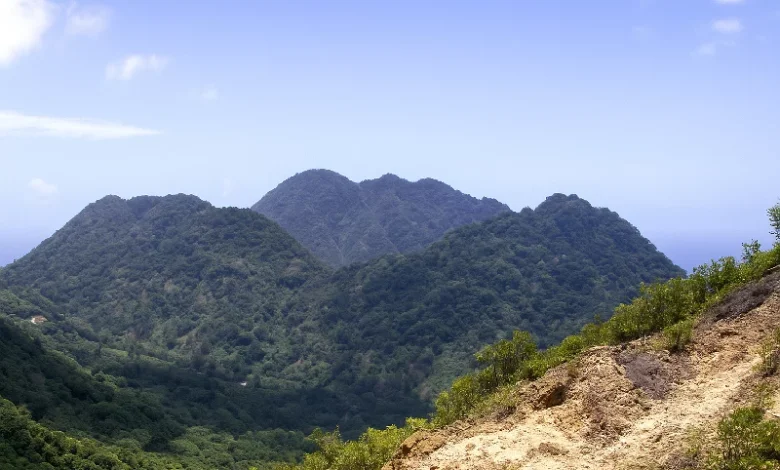Morne Plat Pays Volcanic Complex

The Morne Plat Pays volcanic complex dominates the southernmost part of Dominica and remains one of the island’s most geologically active and scientifically significant features. A dramatic caldera marks this stratovolcano, created approximately 39,000 years ago during a powerful explosive eruption and subsequent flank collapse. The arcuate depression, which stretches from Morne Plat Pays to Soufrière Bay, forms a semicircular scar open to the west, cutting across the volcano’s southwest side. Within and around this depression, at least a dozen lava domes have since emerged, including a submarine dome just south of Scotts Head.
The youngest confirmed eruption at the complex originated from the Morne Patates lava dome around 1270 AD, producing characteristic block and ash flow deposits. Though younger deposits are suspected, they have not yet been formally dated. The area’s active volcanic history makes it a central point of interest for volcanologists and disaster risk experts across the Caribbean.
Seismic Activity and Fumaroles
Since 1765, at least ten earthquake swarms have been recorded in the Morne Patates area. These events, though not directly linked to eruptions, reflect the volcanic complex’s ongoing activity. The region is also home to active fumarolic fields, including persistent steam vents, hot springs, and sulfur-emitting fissures. These geothermal expressions are scattered across the Galion thermal area, Soufrière Sulphur Springs, and Morne Patates, indicating a shallow magmatic system and underscoring the area’s potential for geothermal energy.
The presence of these features has spurred both research interest and economic initiatives tied to sustainable energy development. Studies suggest that the Morne Plat Pays complex is one of Dominica’s key geothermal reservoirs, capable of supporting renewable energy goals while requiring careful monitoring for hazard preparedness.
Ecological and Regional Relevance
The volcanic complex plays a central role in shaping the ecosystems and human settlements in southern Dominica. Dense forests along its slopes nurture endemic flora and fauna, while the rugged landscape channels rainfall into ravines and rivers that feed the Soufrière, Scotts Head, and Galion communities. These waterways are also critical to agriculture and local livelihoods, blending natural beauty with utility.
From an environmental standpoint, the volcanic soils support diverse tropical vegetation and are vital for farming in the surrounding communities. However, proximity to a potentially active volcanic system places these same areas, especially Soufrière and Scotts Head, at heightened risk, necessitating ongoing seismic and geothermal monitoring by the Office of Disaster Management and international partners.
Scientific and Educational Importance
The Morne Plat Pays Volcanic Complex is considered one of the most studied volcanic systems in the Lesser Antilles. Its layered dome structures, eruptive history, and seismic behavior provide essential insights into caldera-forming processes and dome resurgence. Institutions like the Seismic Research Centre (UWI) and international geologists continue to conduct hazard mapping and gas sampling throughout the region.
For educational and outreach purposes, the area also serves as a field site for environmental science and disaster risk reduction programs. Hiking routes and viewing points around Morne Plat Pays, while cautiously approached, offer dramatic vistas and learning opportunities for residents, students, and visitors interested in Dominica’s volcanic landscape.




